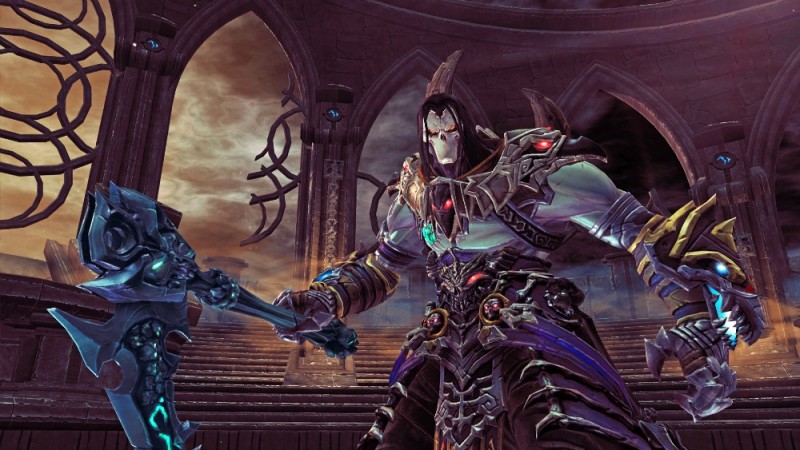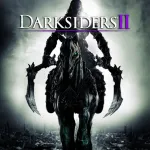Our extra-large special edition is here. Subscribe today and receive the 25% longer issue at no extra cost!
Darksiders II Review

Darksiders concludes with a hell of a tease. War, one of the Four
Horsemen of the Apocalypse, stands ready for action. “You will be
hunted,” angel Uriel warns. “The White City for certain…The Council…and
there will be others! You would wage this war alone?!” The rider calmly
turns to her, raises a fist, and says, “No. Not alone.” The camera pans
up and centers on three flaming objects rocketing toward Earth. War’s
fellow horsemen are coming to fight at his side. The screen fades to
black, and the wait for the sequel begins.
Bury your
excitement for War uniting with his fellow Apocalyptans. Developer Vigil
Games instead takes us back in time to the beginning of Darksiders,
when War is accused of inciting a conflict between Heaven and Hell.
Rather than revisiting this scenario from his perspective again, we see
how these events affect his brother Death, the most feared Horsemen of
them all.
Death’s story runs in parallel with War’s arc, set in
the 100-year span when War is imprisoned in the Charred Council. He is
questing to free his brother and save mankind from the apocalypse. His
goal is clearly defined, but Death’s journey quickly devolves into
multi-part fetch quests with little in terms of gripping narrative
progression. Because of the throwaway fiction, Death is a faceless lead
who spends most of his time excavating rare artifacts from dungeons. His
only significant story contribution comes when the final boss is
defeated after 20-plus hours of play.
That doesn’t make him a bad
character. He may come across as an antique collector that specializes
in rare, oversized, magical keys in the story, but when he enters a
dungeon, his wide set of skills turn him into one of gaming’s most
extraordinary protagonists.
Outfitted with a move set geared for speed, necromancy, and raw power, Death is an efficient killing machine that lets players select their means of evisceration. I gravitated toward his necromancy skill tree, allowing him to summon ghouls to distract and attack enemies. As they tear away flesh, Death can retreat to the battle’s perimeter to call forth a murder of crows that further confound the enemy. Powers like these are fun to use, and get even more potent as players improve them through the skill tree.

Death’s close quarters approach is equally as exhilarating. His speed
– and the fact he carries two scythes – make him a more acrobatic
combatant than his brother. He darts between enemies with ease to
unleash combos that are so violent and lightning quick that the action
is often obscured by vast amounts of blood, magical effects, and blurred
movement. In some combat scenarios, this becomes so severe (and
awesome) that I lost track of Death completely. It’s a good problem to
run into.
Switching between weapons mid-combo is seamless, and
the art of chaining together lengthy attacks relies on careful timing
for both weapon strikes and evasive rolls. Finishing moves are still a
part of the fray, but appear less frequently, and are now nice surprises
opposed to being the easiest way to drop a foe.
Standard enemy
encounters are balanced well, putting players’ skills to the test in
most instances. Since Death is geared to handling multiple threats at
once, fights consisting of a singular boss are usually cakewalks.
Towering, Shadow of the Colossus-like titans fall after a few
undemanding scripted attacks. Even the last boss, who is hardly
mentioned in the story, falls like a mid-dungeon chump.
The
addition of loot – a dizzying array of weapons and armor with different
damage, arcane, elemental, and bonus attributes – adds even more variety
to an already deep and satisfying combat system. The loot system is
beautifully implemented into both combat and questing. I explored every
nook and cranny in dungeons, and downed every foe I saw just to make
sure I wasn’t missing out on the chance of a rare possessed weapon
dropping. These weapons get stronger when you sacrifice other weapons to
power them up. Feeding weapons to weapons – how cool is that? All
possessed weapons have level caps. I wanted to use my possessed scythes
for the entirety of the game, but as I leveled, they no longer packed
the needed punch. Thankfully, I found another possessed weapon later on
that sliced and diced efficiently through the end game.
Having an
expanding arsenal at your fingertips makes New Game Plus, the
Apocalyptic and Nightmare difficulty settings, and Crucible’s arena
challenges more appealing and approachable.
Although the dungeons are built on the
familiar framework of water, fire, time, and the series’ portal themes,
most are architectural wonders filled with inventive puzzles, and sights
so beautiful it's worth taking a second to stop to admire them. Vigil
does a tremendous job of using Death’s move set for dungeon navigation
and puzzle solving. Toward the end of the game, some of the dungeons
feature elaborate puzzle machinations that call upon the use of multiple
abilities. Out-of-the-box thinking is required for a few solutions.
Some
of these dungeons are overly long, but with so many different elements
tied to the gameplay, they rarely feel like they are repeating the same
steps just to lengthen the overall game time. The three-dungeon “Court
of Bones” quest is particularly impressive in its array of puzzles and
combat scenarios. The only dungeon that I didn’t enjoy revolves around a
firearm called Salvation. This dungeon plays out like a shooter level,
and a bad one at that. Death unloads magical angel bullets at waves of
enemies for far too long. This experience doesn’t fit with the rest of
the game, and almost comes across as a comical interlude between acts.
One
of the most polished aspects of the game is environment traversal.
Death can run along walls and leap between pillars much like the Prince
of Persia. These platforming-like sequences add an element of
verticality to exploration, and are used extensively to unearth hidden
areas. The overworld is filled with them (including numerous bonus areas
and bosses). A handy fast travel ability makes backtracking painless
affair.
After finishing Darksiders, I hoped the sequel would
continue with the Four Horsemen riding together in aid of War. That
thought faded once Death let his scythes do the talking. Like Kratos and
Dante, playing as this reaper gives you that amazing feeling of being
an all-powerful ass-kicker.

Get the Game Informer Print Edition!
Explore your favorite games in premium print format, delivered to your door.
- 10 issues per year
- Only $4.80 per issue
- Full digital magazine archive access
- Since 1991







